#teleosauroidea
Explore tagged Tumblr posts
Text
Croc Paleontology Recap January 2025
The year has just begun and already we got a bunch of pretty neat new studies on fossil pseudosuchians so I'll just briefly go over them and unless I forget or end up procrastinating/getting too busy I'll hopefully be able to keep this going throughout the rest of the year.
Just to give you a brief overview, the highlights of this month include: salt glands in gavialoids, crocodilian predation on azhdarchids, diversifications and extinctions in thalattosuchians and a new species of aetoaur from India. Lets begin.
Evidence for salt glands in gavialoids
Starting off with something relating to the dispersal of gavialoids, we got "Evaluation of the endocranial anatomy of the early Paleogene north African gavialoid crocodylian Argochampsa krebsi and evolutionary implications for adaptation to salinity tolerance in marine crocodyliforms" by Pliggersdorfer, Burke and Mannion.
The title already gives a lot away, but the point was that Argochampsa, from the early Paleocene Ouled Abdoun Basin in Morocco, was examined for evidence of salt tolerance. Why? Because the dispersal of gavialoids remains weird. Both modern forms aren't especially keen on saltwater and are only known to consistently occur in freshwater (tho we have a recent example of an indian gharial caught in a fishing net off the coast of India), yet we have plenty of extinct gavialoids that either indicate that the group must have crossed oceans (see any "gryposuchine") or straight up lived at sea (also see some "gryposuchines").
Now, one such example might also be Argochampsa. Both because the Ouled Abdoul Basin famously preserves coastal deposits and because, at least following some phylogenies, Argochampsa might be closely related to the gharials of South America and today (others say its not even a gavialoid but lets ignore that for now). So all things considered one might expect marine habits from Argochampsa, yet so far no such adaptations could be identified. Well, Pliggersdorfer and co. analyzed a thus-far undescribed skull and actually managed to find something. Small depressions on the inside of the skull are suspiciously similar to ones seen in the extinct, fully marine metriorhynchoids, depressions that in the latter have been interpreted as having been left by salt glands. There is also some further evidence through the morphology of the inner ear.
This conclusion further extends to a handfull of other taxa, including the dyrosaurid Rhabdognathus and the recently named gavialoid Sutekhsuchus, and lends itself to the hypothesis that salt glands may have been ancestral to gavialoids, something I personally find unsurprising given their proximity to crocodyloids and their dispersal across the world (really if anything alligatoroids seem like the odd one out).
Fun fact, yours truly is featured in the paper in the form of two silhouettes.
Left: Argochampsa, illustrated by Seismic Shrimp/JW Right: Piscogavialis, perhaps the most famous marine gavialoid, illustrated by Joschua Knüppe

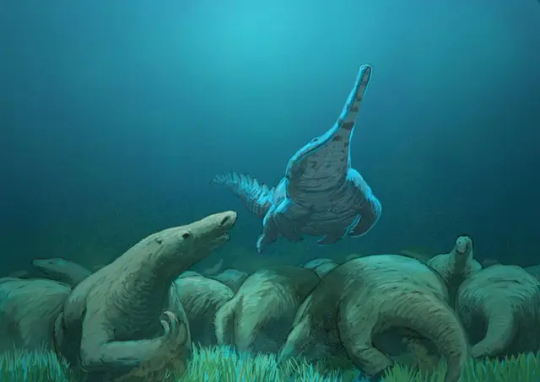
The brain of Paralligator
Second on our neat little list, the neuroanatomy of Paralligator, studied through CT scans and 3D modeling and published on in "Neurocranial anatomy of Paralligator (Neosuchia: Paralligatoridae) from the Upper Cretaceous of Mongolia". Given that I am not great with brain things, I'll keep this one short.
Now for those unfamiliar, Paralligator is part of a somewhat strange clade known as the Paralligatoridae, which contrary to their name are nowhere near real alligators (tho some do look deceptively similar). Instead, they are much more basal members of Eusuchia.
Measurements of the olfactory bulbs, responsible for the sense of smell, indicate that in Paralligator this sense was similarily developed to allodaposuchids and crocodilians, as is the inner ear who's anatomy suggests a semi-aquatic lifestyle. Paralligator does however differ in possessing a mesothemoid, a bony septum in the olfactory region that is also seen in dyrosaurids, baurusuchids and dinosaurs, but not modern crocodiles.

Borealosuchus remains from Colorado
Tho seemingly unexciting, this study, "First record of Borealosuchus sternbergii from thelower Paleocene Denver Formation (lower Danian),Colorado (Denver Basin)" actually helps us fill a neat little gap in our previous knowledge on croc survival across the Cretaceous-Paleocene extinction.
Simply put, though America's croc record across the KPG is rather remarkable, showing both many survivors and some incredible diversification after the impact, Colorado is kind of a blind spot, despite its potential importance. Perhaps one of the best examples of a survivor concerns the genus Borealosuchus, which is both geographically and stratigraphically widespread. To put things into perspective, this genus occured as far north as Canada and as far south as Texas, first appearing in the Late Cretaceous and dying out in the Eocene.
This paper now described several skulls from the Corall Bluff's locality of the Denver Formation, earliest Paleocene, that can be attributed to Borealosuchus sternbergii, definitively extending its range beyond KPG (granted, there are tentatively referred Paleocene occurences elsewhere), making it one of the largest suvivors of the mass extinction, with adults growing up to 2.3 meter in length. The specimens from Colorado are smaller, in the 1.5 to 1.7 meter range, but they are also regarded as immature individuals and are therefore also regarded as usefull in illustrating how the animals changed as they grew into adulthood.
This paper is especially well timed for those that follow @knuppitalism-with-ue 's Formation Stream series. As you might know, Corall Bluffs is to be drawn barely a week from now and this is a fantastic addition.
Left: Borealosuchus drawn by Atak_Draws Right: Distribution of Borealosuchus by Lessner, Petermann and Lyson 2025
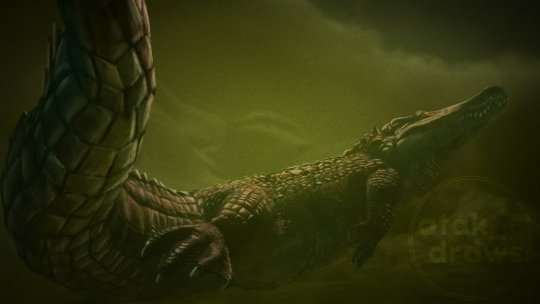
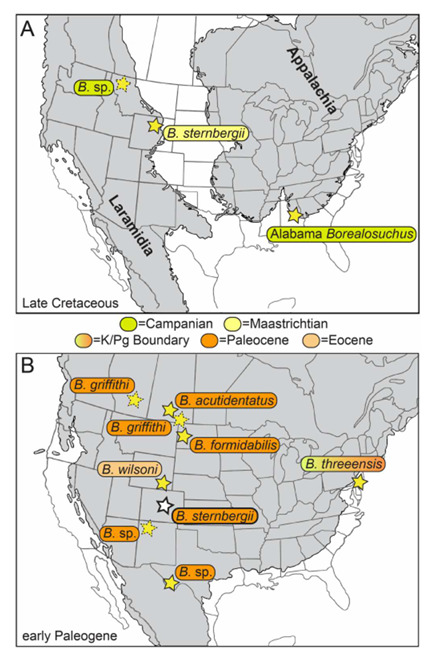
Growth of a peirosaur
Our next paper for discussion is "Life history and growth dynamics of a peirosaurid crocodylomorph (Mesoeucrocodylia; Notosuchia) from the Late Cretaceous of Argentina inferred from its bone histology" by Tamara G. Navarro and colleagues. This study conducted the first histology of peirosaurid limb bones, specifically of an indetermined taxon clading together with Uberabasuchus.
As a brief refresher, peirosaurids are a branch of medium to large sized Notosuchians that I personally think can be aptly described as appearing somewhat like scaly dogs or pigs with often robust, wedge-shaped heads and heavily armored bodies.
The results show that the animal had reached sexual maturity, yet was not yet fully grown. What's also noted is the exact growth dynamics of this animal. This is to say, the studied peirosaurid had overall slow growth with cycles of no growth whatsoever and two periods of increased growth, tho once put against other notosuchians the study deems the growth rates to be better described as "moderate". Pepesuchus meanwhile, belonging to the closely related itasuchids, was a fast grower. Extending things beyond their shared clade shows a virtual mish-mash of dynamics, with Araripesuchus buitreraensis displaying slow growth rates (yet Araripesuchus wegeneri having faster rates than the peirosaur), Iberosuchus showing slow rates, and Notosuchus displaying high growth rates (hell, theres even variation between individuals). A final point concerns the age of the individual, which is....contradictory. Based on the limb bones, the study estimates that the animal was at the very least 15 years old, but previous study of the osteoderms has yielded an estimated age of 18 years old. Ultimately, further study is needed, but it does clearly show how the histology of different parts of the skeleton varies.
Shown below, Uberabasuchus terrificus by Scott Reid

Predation on pterosaurs
Here's a fun one, "A juvenile pterosaur vertebra with putative crocodilian bite from the Campanian of Alberta, Canada", once again with a name that tells you very much what you're in for.
Brown and colleagues report on the discovery of a juvenile specimen of the azhdarchid Cryodrakon from the Dinosaur Park Formation of Alberta, Canada. The neck vertebra bears some conical bite marks, notably different from those of theropods, which generally have D-shaped or compressed tooth crosssections (sans spinosaurids, which aren't present). Champsosaurus is also ruled out due to its inferred feeding preferences, weak bite force and slender teeth. Mammals are potential candidates, but the team regards it as more likely that the trace maker was a crocodilian. Considering the fauna of the Dinosaur Park Formation, this would suggest the culprit was either Leidyosuchus, Albertochampsa or an animal described as "Stangerochampsa-like".
Now this is a very interesting, if not exactly unexpected interaction. On the one hand, having direct fossil evidence for this is a big deal, even if we don't know if the bite marks were left due to the pterosaur being actively hunted or if they were simply left when a lucky croc came across the carcass of an already deceased Cryodrakon. On the other hand, crocodiles and kin are notoriously opportunistic and broad in their diet, so one feeding on a pterosaur is something that seems like a no-brainer in principle, especially a relatively small individual with a wingspan of "only" 2 meters. This is further supported by the fact that crocodilian bite marks have also been reported from the Romanian pterosaur Eurazhdarcho.
Obvious difference in prey size and geography aside (and taxon names even within the chosen setting while we're on it), Prehistoric Planet really nailed the nailon the head with this one.
In the left corner, a juvenile Cryodrakton (art by Hank Sharpe). In the right corner, Leidyosuchus (art by Gunnar Bivens) LET THEM FIGHT (or scavenge)
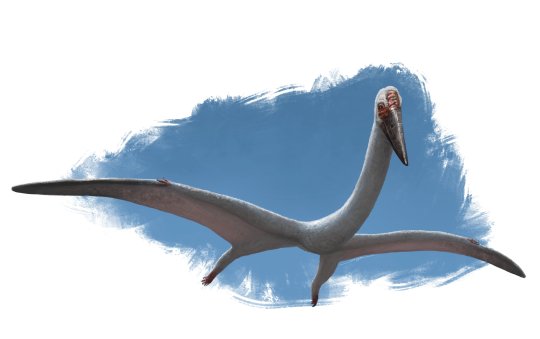
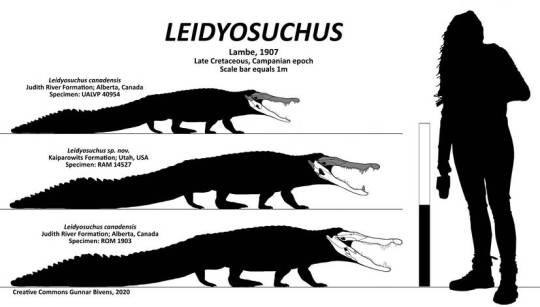
Evolutionary trends and extinctions in Thalattosuchia
This one's a last minute entry, by which I mean this one got just published as I was about to wrap this whole thing up. "Analysing Thalattosuchia palaeobiodiversity through the prism of phylogenetic comparative methods" explores how the evolution and the extinctions of members of this group were shaped by both biotic and abiotic factors.
Given the shere breadth of this topic, a quick summary of thalattosuchia seems kinda in order. In short, thalattosuchians are a group of what are likely to be early crocodyliforms adapted to life at sea. They can be split into two groups, the teleosauroids, superficially gharial like animals that likely stuck to coastal waters, and the metriorhynchoids, open ocean animals with fluked tails, no body armor and paddle-like limbs. Both groups reached their greatest diversity in the late Jurassic, but managed to survive into the Cretaceous before disappearing entirely.
The study recaps that thalattosuchians first reach great diversity during the Toarcian, tho this is likely influenced by preservation bias thanks to Lagerstätten such as the Posidonia shale, and a later diversification takes place during the Bathonian. Regardless, the transition from the lower to middle Jurassic sees an increased trend in both thalattosuchian groups towards shorter snouts, which are associated with durophagy or hypercarnivory. This essentially gives rise to the teleosauroids of the Machimosaurinaei, which appear during the Bathonian and have blunt, robust teeth, as well as the metriorhynchoid Geosaurinae, which appeared at the same time and had ziphodont (serrated teeth). The reasons for this could be twofold. On the one hand, thalattosuchians were very abundant, so expanding into new nisches helped them coexist, with ecosystems preserving fish-eaters, hypercarnivores, durophages and more at the same time. More of an underlying factor could be a drop in ichthyosaur diversity, leaving plenty of open nisches for these crocs to fill.
Subsequently, during the transition from the Middle to Late Jurassic, there was another diversification event with both groups establishing new major clades, possibly associated with the warm temperatures of the Late Jurassic, before the diversity crashes with the onset of the Cretaceous. The authors note that this too might have been related to climate, with the Cretaceous survivors mostly being found in warmer waters.
Left: A Dakosaurus ambushing an ichthyosaur by Gabriel Ugueto Right: A large Machimosaurus rests on the beach as a sauropod approaches, art by Joschua Knüppe
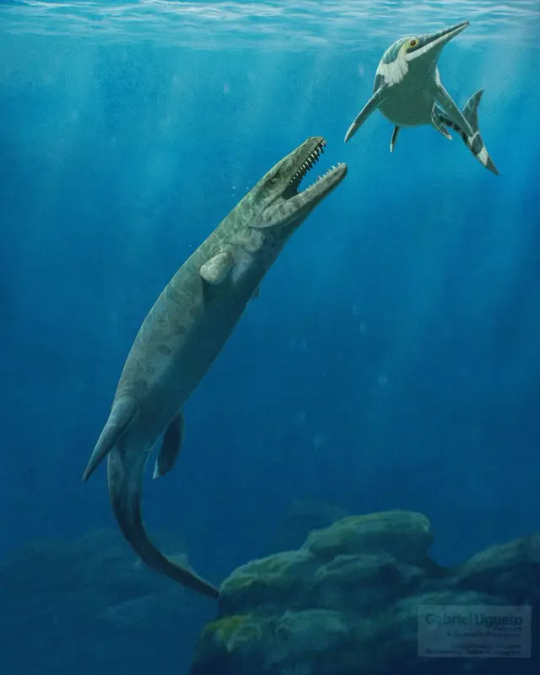
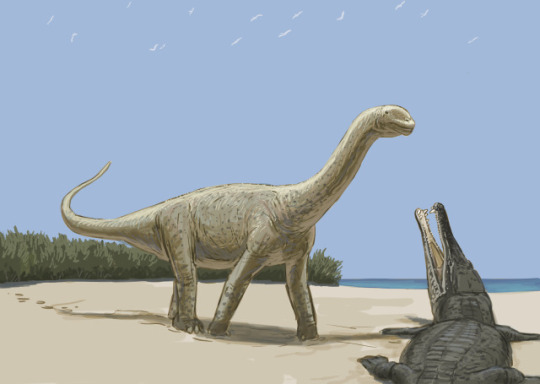
and for the final study I wanna talk about
Kuttysuchus: A new Aetosaur from India
Now, by all accounts one might be surprised to see this just kinda thrown in at the end here rather than getting a dedicated post as I usually like to do with new forms. And truth be told, theres just not that much to say about "A New paratypothoracin aetosaur (Archosauria: Pseudosuchia) from the Upper Triassic Dharmaram Formation of India and its biostratigraphic implications".
Kuttysuchus is our first pseudosuchian to be described this year and to get things out of the way, its not super exciting in terms of material. Like some other recently named aetosaurs, Kuttysuchus is based entirely on a handfull of osteoderms. And there's nothing wrong with that, after all osteoderms are rather distinctive for these animals. It does however mean that the information we can get from them is a bit limited and thus makes it hard to really put together something engaging.
More interesting than the anatomy then is the range and its relationship to other aetosaurs. The fossils are known from the Dharmaram Formation of India, which you might recall is also home to the recently named Venkatasuchus. Both Venkatasuchus and Kuttysuchus are members of the Paratypothoracini, tho the former is significantly more derived and the latter more basal.
Fossil osteoderms of Kuttysuchus, all belonging to the central double row that stretches across the back.
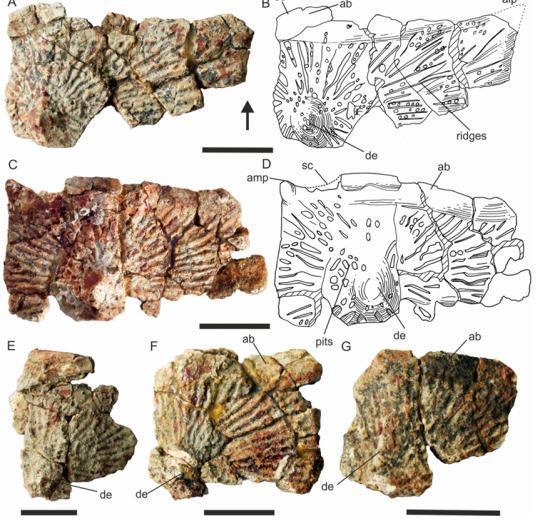
I'll be entirely honest. This was a lot more work to type out than anticipated, but admittedly also fairly rewarding. Hopefully you dear reader found it equally interesting, and hey, congrats on making it to the end.
#palaeoblr#paleontology#prehistory#croc#crocodile#long post#pseudosuchia#sutekhsuchus#argochampsa#peirosauridae#thalattosuchia#metriorhynchoidea#teleosauroidea#kuttysuchus#aetosauria#paralligator#leidyosuchus#cryodrakon#borealosuchus
142 notes
·
View notes
Text
Two more croc-line archosaurs to dig into with this one and both are super fascinating.
Obviously the star of this piece is our friend in the foreground, Plesiosuchus manselii, the largest of the fully marine metriorhynchids (the skull of which being the first one shown in the image to the right, taken from Young et al. 2012)
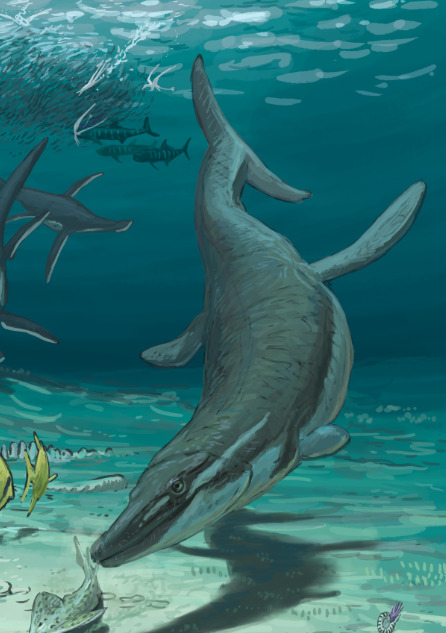
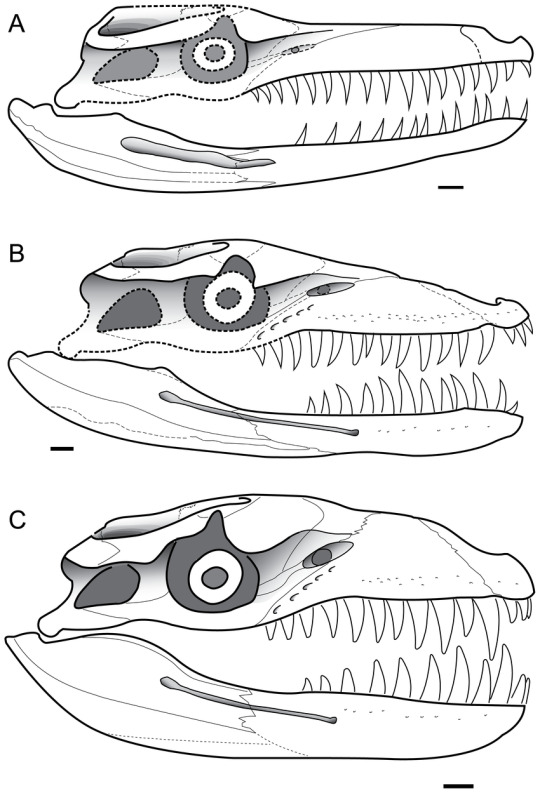
More broadly speaking, metriorhynchids are a fascinating group of early croc-relatives that stand out for having returned completely back into the water, developing a fluked tail, tiny little reduced forelimps, flipper like hindlimbs and smooth skin entirely lacking in the osteoderm armour we so strongly associate with pseudosuchians.
Plesiosuchus specifically is the largest of them. Close to 7 meters in length, it's basically in the same range as Liopleurodon (although smaller than several of the pliosaurs we know from the Kimmeridge Clay like that very decorative skeleton). Plesiosuchus actually wasn't the only metriorhynchid from the formation either. We also know of the small Cricosaurus, the name-giving Metriorhynchus and most interestingly the large-bodied Dakosaurus and Torvoneustes, which were likely to reach lengths of 4.5 to 4.7 meters respectively. At least with metriorhynchids this diversity can be explained in the different animals having very different preferences. Torvoneustes is interpreted as a durophage, feeding on hard-shelled prey. Dakosaurus is characterized by slicing dentition, potentially able to cut apart large prey with tooth wear possibly suggesting sharks or suction feeding habits. Plesiosaurus meanwhile would be able to take on large prey simply due to its great size and large gape but may have been limited by the size of its own head.
The other marine "croc" in the image is Bathysuchus, which may be described as a cousin to the metriorhynchids.
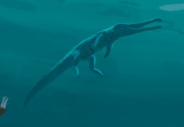
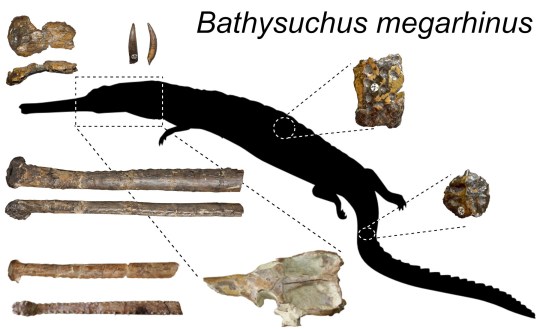
Remember Machimosaurus from the Guimarota locality that Josch drew a few weeks back? Yeah its related to that one. A teleosauroid to be precise, which are the sister group to metriorhynchoids and appear much more croc-like in their appearance despite still being a long way off from crocodiles in the strict sense. Teleosauroids may appear like what you'd think of as basal to metriorhynchoids, but they simply did their own thing after diverging, thus retaining this more ancestral bauplan with more developed limbs, more croc-like skulls and maintaining their armour plating (keep that in mind).
Bathysuchus is kind of a weird one tho. Why? Because from what we can tell Bathysuchus seems to have tried to become more like its metriorhynchoid cousins. It's known from deeper waters, its osteoderms were much more reduced and if the closely related Aelodon is anything to go from then its quite likely that this guy also started reducing the size of its forelimbs. In short, adaptations to a more pelagic lifestyle that moves away from the coastal habitat other teleosauroids seem to have preferred. Who knows, maybe its possible that in some other timeline these guys might have become something akin to metriorhynchoids like what happened with mosasaurs.
Unlike metriorhynchoids, teleosauroids were way less common in the Kimmeridge Clay, hell, to my knowledge Bathysuchus is the only one of them, a pretender among the other pelagic pseudosuchians.
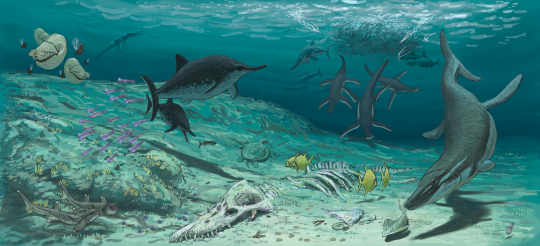
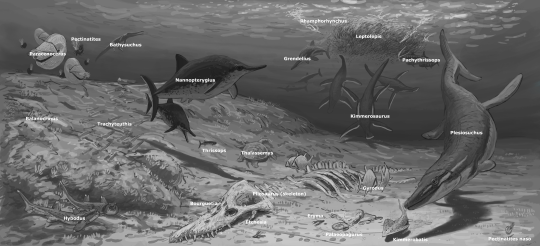
Result from the Kimmeridge Clay #paleostream!
We were only able to scratch the surface, but I think you get the idea ;)
#bathysuchus#plesiosuchus#kimmeridge clay#crocs#pseudosuchia#crocodile#metriorhynchidae#metriorhynchoidea#teleosauroidea#thalattosuchia#crocodyliform#jurassic#marine croc#paleostream#palaeoblr
599 notes
·
View notes
Text
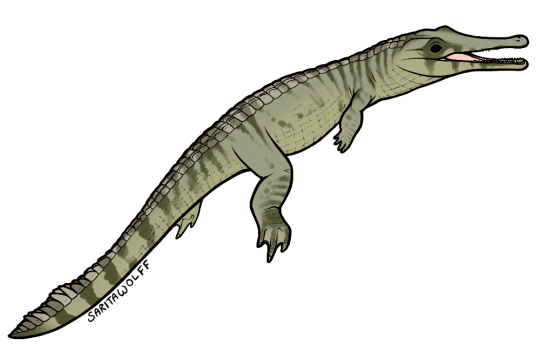
Patreon request for @/rome.and.stuff (Instagram handle) - Turnersuchus hingleyae
Described just last year, the Early Jurassic Turnersuchus is the most basal known member of the thalattosuchians: sea-dwelling crocodylomorphs. It existed before the two major thalattosuchian groups, the paddle-limbed Metriorhynchoidea and the long-snouted Teleosauroidea, split, and it may be the ancestor of both. While only parts of the skull are known, its shape suggests a narrow snout that was not as long as that of later thalattosuchians. Only one osteoderm is known, and it is oval with a slight keel down the middle, believed to have been attached to the tail. As humble as this small pseudosuchian was, it helped us fill in the major gaps of our understanding of thalattosuchia, and finally gave us an idea of their origin. Previously, all we knew was that the highly-derived metriorhynchoids and the more crocodile-like teleosauroids were related, lived alongside each other, and seemingly appeared in the Jurassic. While not as well known as the icthyosaurs, plesiosaurs, and mosasaurs, thalattosuchians were very successful sea crocodylomorphs until around the Early Cretaceous, and they owe their success to this little pseudosuchian who decided to return to the sea.
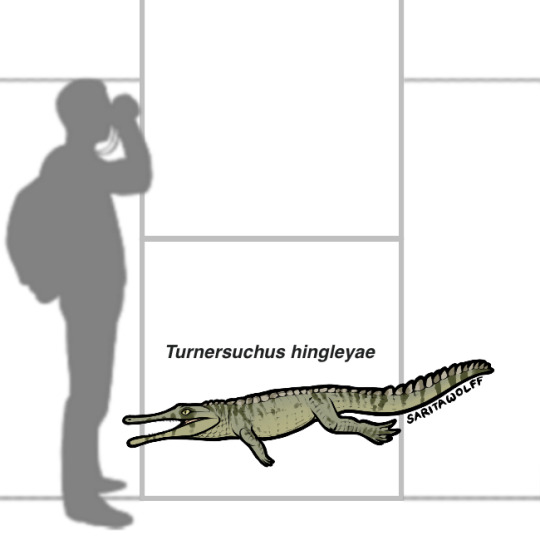
Found in the Charmouth Mudstone Formation of England, Turnersuchus would have lived alongside a variety of ammonites like Phricodoceras and Gemmellaroceras, as well as icthyosaurs like Leptonectes. It likely fed on the small fish that lived here. As it was not as highly adapted for ocean life as its descendants, it may have spent some time basking on land, where it could have come across early dimorphodontid pterosaurs and the armored Scelidosaurus.
#my art#Turnersuchus hingleyae#Turnersuchus#Thalattosuchians#crocodylomorphs#pseudosuchians#archosaurs#archosauromorphs#reptiles#SaritaDrawsPalaeo#Charmouth Mudstone Formation#Early Jurassic#England
8 notes
·
View notes
Photo
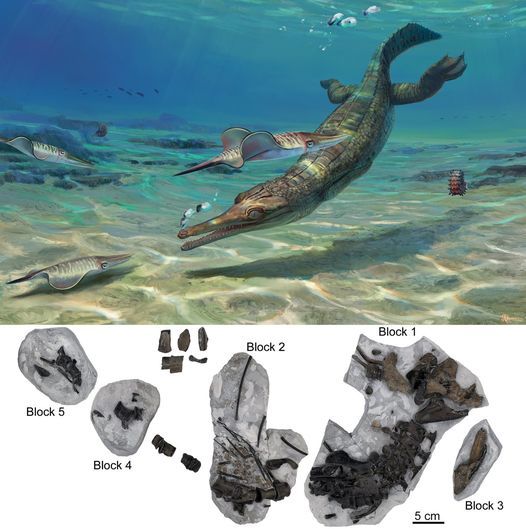
A new early diverging thalattosuchian (Crocodylomorpha) from the Early Jurassic (Pliensbachian) of Dorset, U.K. and implications for the origin and evolution of the group
Eric W. Wilberg,Pedro L. Godoy,Elizabeth F. Griffiths,Alan H. Turner &Roger B. J. Benson
ABSTRACT
Among archosaurs, thalattosuchian crocodylomorphs experienced the most extensive adaptations to the marine realm. Despite significant attention, the phylogenetic position of the group remains uncertain. Thalattosuchians are either the sister-group to Crocodyliformes, basal mesoeucrocodylians, or nest among longirostrine neosuchians.
The earliest definite thalattosuchians are Toarcian, and already possess many synapomorphies of the group. All phylogenetic hypotheses imply a ghost lineage extending at least to the Sinemurian, and a lack of older or more plesiomorphic forms may contribute to the uncertain phylogenetic placement of the group.
Here we describe a new species, Turnersuchus hingleyae, gen. et sp. nov., from the early Pliensbachian Belemnite Marl Member of the Charmouth Mudstone Formation (Dorset, U.K.). The specimen includes partially articulated cranial, mandibular, axial, and appendicular elements. It can be attributed to Thalattosuchia based on the following features: distinct fossa on the posterolateral corner of the squamosal; broad ventrolateral process of the otoccipital covering the dorsal surface of the quadrate; large supratemporal fenestrae lacking a flattened skull table; broadly exposed prootic; orbital process of quadrate lacking bony attachment with the braincase. This specimen represents the earliest thalattosuchian currently known from diagnostic material.
Phylogenetic analyses of two published datasets recover Turnersuchus as the earliest diverging thalattosuchian, and sister to Teleosauroidea + Metriorhynchoidea. Bayesian tip-dating analyses suggest a Rhaetian or Sinemurian divergence of Thalattosuchia from other crocodylomorphs, depending on topology, with confidence intervals spanning from the Norian to the Pliensbachian.
The new specimen extends the fossil record of Thalattosuchia, but the time-scaling analyses demonstrate that a significant ghost lineage remains.
Read the paper here:
https://www.tandfonline.com/doi/abs/10.1080/02724634.2022.2161909
23 notes
·
View notes
Text
Croc Paleontology Recap Febuary 2025
January passed so fast probably cause its the shortest month but we still got a handfull of papers out of it. So lets get right into it.
The function of the armor of Stagonolepis
Getting us started in the Triassic is a paper on the osteoderms of the aetosaur Stagonolepis: "The histology and function of the dermal armour of the aetosaur Stagonolepis olenkae Sulej, 2010 (Archosauria, Pseudosuchia) from Krasiejów (SW Poland)". Now as you probably figured from the handfull of times I've talked about aetosaurs on here, their osteoderm armor is very characteristic, very important in telling them apart and VERY extensive.
The results of this study are interesting. For starters, although osteoderms frequently serve a function in thermoregulation in modern crocs and even temnospondyls, this does not appear to have been the case for Stagonolepis. Now superficially, aetosaur osteoderms do show the same pitted surface as modern croc armor, which is caused by the elements absorbing bone and depositing it elsewhere throughout growth, something that reduces mass while maintaining stability and also increases surface area. However, Stagonolepis osteoderms are not vascularized like those of modern crocs, lacking the densely packed blood vessels that help absorb heat. The external surface of the osteoderms also doesn't show signs of thick sharpeys fibres, which are generally used to anchor the osteoderm in the soft tissue. What this means is that the osteoderms were not deeply embedded in skin (as has been suggested for some notosuchians) but rather were covered in keratin like those of modern crocs. But if not for thermoregulation, then what are the osteoderms for. Well on the one hand, obviously they work as armor. Their structure makes them robust yet leight weight and they are firmly embedded through sharpeys fibres present on the lower cortex of the osteoderms (tho its highlighted that they aren't as densely packed as in ankylosaurs). The keels that mark the osteoderms further prove to be quite usefull when it comes to reducing stress from a vertical attack. If you really want an additional reason for the armor, the authors offer the suggestion of being an adaptation to prevent water loss. Finally, histology shows that the osteoderms do not feature lines of arrested growth (basically signs for poor growth throughout the animals life), which suggests that the environment inhabited by Stagonolepis was quite moderate and did not have strong seasons that might influence the animals growth throughout its life.
Bottom: A diagram of Stagonolepis is sideview, showing the various types of osteoderms covering its body. Reconstruction by S. Górnicki

Growth strategy in Trialestes and its implications
Up next something not too different from a study we had in January. Last time we had a study on the growth of a peirosaurid notosuchian, this time "A fast start: Evidence of rapid growth in Trialestes romeri, an early Crocodylomorpha from the Upper Triassic continental beds of Argentina based on osteohistological analyses" brings us something similar except for the "sphenosuchian" Trialestes (more on that group later).
So what did we learn? Well for starters, neither of the examined specimens (which included the holotype) were mature, both in terms of sexual maturity and skeletal growth. What is weird is that morphology (specifically bone fusion in the vertebra) indicates the opposite to what has been concluded based on bone microstructure, which may suggest that in Trialestes either reached sexual maturity at a delayed rate of that histology and sexual maturity do not correlate all that much. Anyhow, based on crosssections of the bones, they are estimated at a minimum of two years and one year of age at the time of their deaths. Histology also shows that Trialestes appears to have grown quite rapidly. Curiously a previous study estimated a third specimen to have been one year old, eventhough this new study recovered the same age for a specimen only half that size. This seems to suggest that age and growth do not really correlate for some unknown reason, with possible explanations including differences between sexes or simply differing environmental conditions. Looking at the results at a grander scale, similar growth rates have previously been calculated for other nimble crocodylomorphs such as Terrestrisuchus and Saltoposchus, with the latter growing even faster than Trialestes. Of course when you get into more derived members of Crocodylomorpha strategies start to change, for example the slightly more derived Hesperosuchus was growing at a slower speed than Trialestes and if you recall January we know that Notosuchians can differ even within a genus (see Araripesuchus). Modern crocs appear to generally grow slower overall in their ontogeny, tho in some like the broad-snouted caiman environmental conditions seem to play quite the rolle. Nevertheless, the paper concludes that faster growth rates appear to be more widespread in early crocodylomorphs and may have been the ancestral condition.
Below: Reconstruction of the head of Trialestes by Joschua Knüppe (there is really not much art of this guy out there)

Now for two papers that are very relevant to my efforts on Wikipedia, namely two studies on the European alligatoroid Diplocynodon.
Growth strategy of Diplocynodon hantoniensis
First of all, sorta the same thing we just had for Trialestes but applied to Diplocynodon hantoniensis, a species from the Eocene of southern Britain (and actually one of the first Diplocynodon species discovered). The greater goal of "Evolution of growth strategy in alligators and caimans informed by osteohistology of the late Eocene early-diverging alligatoroid crocodylian Diplocynodon hantoniensis", as you might guess from the title, is actually to use Diplocynodon in order to figure out how growth strategies evolved in the two modern groups of alligatoroids, gators and caimans, who share similar strategies despite having been separated from another since before the extinction of the dinosaurs.
With 9 studied upper leg bones, the sample used in the study ranged from immature specimens to adults, which in the case of D. hantoniensis might reach lenghts of 1.2–3.4 meters. The growth strategy of Diplocynodon is recovered as both being determinate (meaning that they stop growing at a certain point) and seasonally controlled (which feels self-explanatory), both also seen in modern alligatoroids. Now assuming that the growth marks accurately reflect yearly intervals (which may not necessarily be the case), then the studied individuals ranged between 5 and 26 years old at the least. Skeletal maturity seems to have been reached in a similar range as modern alligatoroids (gators reaching maximum size between 30 and 40 and caimans between 12 and 18). As with Trialestes earlier, there are some individuals that show signs of being fully grown, yet are less than half the size of other individuals, possibly indicating sexual dimorphism (female gators stop growing earlier and at a lower size than males) or environmental conditions that affected growth (though there is doubt cast over this latter interpretation). The study concludes that, based on Diplocynodon hantoniensis, alligatoroids are simply relatively conservative in their growth strategy and what we see in gators and caimans is likely their ancestral strategy, rather than having been developed independently.
Below: A photo of the skull of Diplocynodon hantoniensis (taken by John Cummings), not actually relevant to the study but I mean it shows what this thing looked like.

The sense of smell and EQ of Diplocynodon tormis
Moving away from the Eocene of the UK and to the Eocene of Spain, we got a different species of Diplocynodon as the main subject of "New data on the inner skull cavities of Diplocynodon tormis (Crocodylia, Diplocynodontinae) from the Duero Basin (Iberian Peninsula, Spain)". Specifically, the study deals with the description of and what we can learn from a CT-scan that gives us insights into the forebrain, olfactory bulbs, nasal cavity, air sinuses, etc..
Overall the shape of the brain matches the idea that Diplocynodon is an early alligatoroid, including some distinctive features of this clade and some traits that are basal to crocodilians. Like modern alligators, Diplocynodon tormis seems to have had a good sense of smell, though not as keen as that of crocodyloids. The holotype specimen falls within the upper values in terms of olfactory acuity among alligatoroids, but still clearly outside of the range exhibited by crocodyloids, while another studied specimen performed a lot poorer (though its also not as well preserved). As for cognitive abilities, the study also calcuated the Reptilian EQ of D. tormis. The authors note that the EQ of Diplocynodon tormis appears below the average of other medium-sized crocodilians and instead comes closer to the EQ of large forms. Tho it is also noted that damage to the specimen might have affected the results.
Left: A 3D model of the holotype skull of Diplocynodon tormis Right: A 3D model of that same skull but highlighting the various internal structures such as the brain, nasal cavity, nerves, etc..


A history, redescription and the biology of the teleosaur Macrospondylus
Ah Macrospondylus bollensis, once known under the name Steneosaurus (like every other teleosauroid lets be honest), perhaps one of the most well known members of this group given its extensive fossil record from the Posidonia Shale in Germany. Despite this, and also like many other teleosauroids, its history is confusing, long and just a whole can of worms. One dealt with in "A re-description of the teleosauroid Macrospondylus bollensis (Jaeger, 1828) from the Posidonienschiefer Formation of Germany".
To give you the abridged version, the holotype of Macrospondylus bollensis was found all the way back in 1755 (meaning it was discovered so long ago even Napoleon wasn't born yet) and quickly recognized as some sort of crocodile relative. It was named Crocodilus Bollensis in 1828, described in the 1830s and given the genus name Macrospondylus in 1831 (and then again by a different author in 1837, seemingly independent of the previous study).
Being this old, of course the fate of Macrospondylus would be shaped by historical events, specifically the German revolutions of 1848–1849, when a fire set by revolutionaries in Dresden grew out of control and spread to the collection, damaging but thankfully not destroying the fossil. Chaos ensued unrelated to that as various researchers proceeded to lump Macrospondylus into either Teleosaurus, Mystriosaurus or even Geosaurus before circling back to Crocodilus, eventually settling on Steneosaurus in the 1960s. Scientists did eventually grow wise to Steneosaurus being an overlumped wastebasket of a taxon, but this was not fixed until 2020 when this gordian knot was hacked to pieces once more, resulting in the revival of Macrospondylus.
Keeping all this confusion in mind, recent work including this paper still finds that Macrospondylus is actually the most abundant Toarcian teleosaur and especially common in Germany (no doubt thanks to the Posidonia Shale, this doesn't necessarily reflect how things were at the time). In terms of ecology, Macrospondylus may have been a long-snouted generalist, being able to consume a much wider selection of and overall bigger prey than some of its rarer relatives. Size might also have been a factor, since large Macrospondylus reach up to 5 meters in length and would therefore have access to more robust and larger prey. Its wide distribution might also suggest that it was less picky than other teleosauroids about where it lived and though previously suggested to have been more marine, this new study seems to favor the idea that it was still fairly amphibious throughout its life. This is interesting given that the Posidonia Shale, where so many specimen are known from, is a pelagic off-shore open ocean environment, with the potentially more terrestrial Platysuchus and the shallow water Plagiophthalmosuchus being much rarer. Of course, there is always the possibility that this idea of Macrospondylus being super common is skewed simply by the preservation and the excavation at Holzmaden, which as said before might not reflect the state of the entire species population.
Left: A fossil of Macrospondylus next to Dr. Michela Johnson, photo by Meike Rech Right: Thalattosuchians from Tübingen by Pascal Abel, the two skeletons on the left wall and the bottom slab on the right all represent Macrospondylus Bottom: Macrospondylus photographed by Sven Sachs



The metabolism of Notosuchians
Back to something less constrained to any specific taxon, we got "Revisiting the aerobic capacity of Notosuchia (Crocodyliformes, Mesoeucrocodylia)",a paper on notosuchian metabolism, which is one of those things that might surprise people unfamiliar with them.
Of course Notosuchia is the great post-Triassic terrestrial radiation of the crocodile-lineage, bringing forth a great diversity of land-dwelling froms from small omniv, ores, bulky herbivores and even lanky carnivores. Despite this, it might come as a surprise that they were in fact not "warm blooded". This is again reinforced by this months paper by Sena and colleagues, who recover that their mass-independent maximal metabolic rates lie somewhere between modern crocs and monitor lizards (which again fits with previous studies on the matter). This means that fitting with their anatomy and lifestyle, they were more active than modern crocs and able to sustain more vigorous activity. Being ecto-thermic, they were still dependent on outside temperatures to heat them up before they were able to really take things to their fullest. Consequently it has also been hypothesized quite a bit that to cool down, they might have entered burrows later in the day.
Left: Two Baurusuchus are shown hunting a small Caipirasuchus, with all individuals shown as being fast, agile and terrestrial. Artwork by Deverson da Silva Right: Armadillosuchus emerging from its burrow under a tree stump with a herd of sauropods in the back. Artwork by Julia d'Oliviera

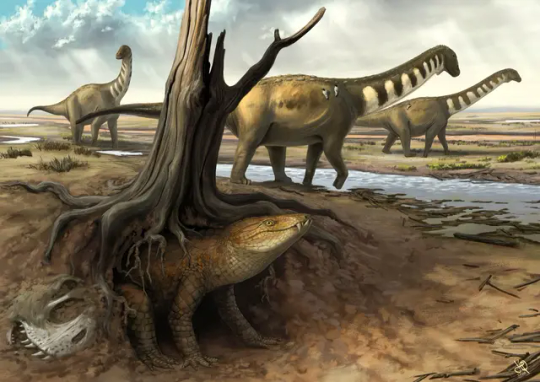
Now, for what I'm guessing all five of you that made it this far have been waiting for. The newly named crocs....which I didn't have time to make dedicated posts for. Look shit sucks alright, weekends have been really brief this month and I feel very tired.
Pattisaura: A new sphenosuchian from Texas
Getting us started on Pattisaura, a new genus of "sphenosuchian" (I told you I'd come back to them) from the Late Triassic Cooper Canyon Formation of Texas. Described in "A new crocodylomorph (Pseudosuchia, Crocodylomorpha) from the Upper Triassic of Texas and its phylogenetic relationships", this little guy generally represents what one might see as a quintessential sphenosuchian. A somewhat body pointed skull with large eyes, terrestrial habits, long and slender legs, a far cry from what we tend to associate with crocodylomorpha today.
The name Pattisaura was coined in honor of Mrs. Patricia Kirkpatrick, who's family has let paleontologist look for fossils on their farm (gee I wonder why that name sounds familiar) and the species name gracilis derives from....I mean do I even need to say it?
Unsurprisingly, the phylogenetic analysis of this study shows that Sphenosuchia is paraphyletic and doesn't actually form a single clade, instead simply representing a series of consecutively branching early crocodylomorphs. What can be said is that Pattisaura seems to clade with Redondavenator.
While perhaps unassuming in size or ferocity, little Pattisaura is nonetheless an interesting addition to the pseudosuchian fauna of the Cooper Canyon Formation, which has previously yielded the remains of the phytosaur Machaeroprosopus, various aetosaurs including Desmatosuchus, Aetosaurus, Typothorax and Paratypothorax, poposauroids like Shuvosaurus and the iconic Postosuchus alongside many other Triassic classics such as drepanosaurs, silesaurids, lagerpetids, coelophysoids and more.
Left: The skull of Pattisaura photographed by Aaron dp Right: The skull in top, bottom and sideview, reconstructed to account for taphonomic distortion and damage to the material


Thilastikosuchus: Brazil's oldest notosuchian
And the final one for this month is Thilastikosuchus scutorectangularis (mammal crocodile with rectangular scutes) described in "Anatomical description and systematics of a new notosuchian (Mesoeucrocodylia; Crocodyliformes) from the Quiricó Formation, Lower Cretaceous, Sanfranciscana Basin, Brazil". This little guy, and I mean little as it is based on a juvenile specimen, was recovered from the Early Cretaceous Quiricó Formation of Brazil and represents a new member of the obscure family Candidodontidae.
To give a brief description, Thilastikosuchus was a small, slender-limbed animal, although admittedly we only have a juvenile to go off from. Its teeth are prominently heterodont, meaning that rather than having jaws filled with relatively similar conical teeth its dentition was a lot more diverse, specifically consisting of subconical incisiforms and molariforms with multiple cusps. The armor of the body, as the name suggests, is rectangular with a smooth outer and back edge, eventually transitioning into the square osteoderms of the tail that possess a prominent keel down their middle. As with most notosuchians, there were only two rows that run down along the spine, rather than the more complex armor seen in modern crocodiles.
Perhaps most interesting are the phylogenetic and evolutionary implications of this animal. Thilastikosuchus is the oldest known notosuchian from Brazil and perhaps even the oldest notosuchian of all of South America, which might have big implications for the groups evolution. It is placed as a member of the Candidodontidae, a family coined to include Candidodon and Malawisuchus but not always regarded as a distinct group throughout publications. This new paper specifically places them at the very base of Notosuchia, branching off even before Uruguaysuchidae and Peirosauria. Given the very mammal-like teeth of candidodontids, this raises the question whether or not such dentition was simply convergently evolved by them and sphagesaurids (assuming their position amongst notosuchians holds true) or if its the ancestral condition that was later lost by groups such as uruguaysuchids and baurusuchids. It also adds an interesting aspect to the diversification of the group. As things stand, the oldest known notosuchian is Razanandrongobe from the Jurassic of Madagascar, but this taxon and its significance are poorly understood. With this new paper, we definitely see a clear diversification of notosuchians in the earliest Cretaceous through candidodontids, another radiation later in the Albian with uruguaysuchids and peirosaurs and a final burst in diversity towards the end of the Cretaceous with the numerous forms known from the Bauru group.
Left: Skeletal reconstruction of Thilastikosuchus with special focus on the osteoderms by Felipe Alves Elias Right: Live reconstruction by the same artist with an adult individual looming in the background


#palaeoblr#paleontology#prehistory#croc#crocodile#long post#pseudosuchia#notosuchia#thilastikosuchus#pattisaura#macrospondylus#teleosauroidea#diplocynodon#alligatoroidea#trialestes#aetosauria#stagonolepis#crocodylomorpha#science news#february 2025#fossils
27 notes
·
View notes
Text
Indosinosuchus the freshwater Teleosaur
Ignoring the fact that I skipped out on posting about my recent deepdives on Armadillosuchus and Odobenocetops (besides that one figure I made) on Tumblr, let me catch up by talking about Indosinosuchus.

Indosinosuchus (Indochinese Crocodile, after the Indochinese Tectonic Block) is a type of teleosaurid from the Late Jurassic Phu Kradung Formation of China. First of all the Phu Kradung is a fascinating formation with a long and somewhat convoluted dating history. For quite some time researchers argued whether or not its Late Jurassic (based on fauna) or Early Cretaceous (based on pollen). Recent papers seem to argue that both can be true, with the lower parts being Jurassic and the upper Cretaceous, which also accounts for a faunal turnover visible throughout the record. Related to Indosinosuchus, we have classically Jurassic teleosaurs in the lower levels and pholidosaurids in the upper.
artwork by Kmonvish Lawan and Sakka Weerataweemat


Whats far more interesting however is that the Phu Kradung Formation is continental in nature, preserving floodplanes dominated by lakes and rivers. This is quite the unusual habitat for a teleosaur, which are traditionally marine animals, living in the coastal or even open waters of the Tethys. In fact the only other known example of a freshwater teleosaur is an unnamed animal from China that sometimes clades closely to Indosinosuchus.
Indosinosuchus is known from a total of 10 fossil individuals, largely consistsing of skulls and mandibles with the occasional postcrania, which were all found in a single locality and have been determined to represent at least two different species: I. potamosiamensis (Thai River Indochinese Crocodile) and I. kalasinensis (Indochinese Crocodile from the Kala Province).


Now overall, Indosinosuchus had a pretty long and narrow snout compared to most modern crocodilians. However, among teleosaurs, this animal was actually among the more robust genera. Even more so when you consider that within teleosaurs, it falls within the teleosaurid family, not the overall more robust machimosaurids that would eventually become durophages and macropredators, cracking turtle shells.
Analysing the biomechanics of Indosinosuchus did show some cool things. The snout was pretty average at resisting stress and force, at least for teleosaurs, but the bite force was respectably high. The force that could be transferred to the tip of the snout in particular is among the highest in this group and the maximum force it could excert was the single highest among all teleosaurs.
The two species however begin to differ in how fast they could close its jaws. I. potamosiamensis follows what would be expected. A teleosaur with a massive bite but only closing its jaws slowly as in teleosaurs with similar mechanical advantage values. I. kalasinesis however could close its jaws surprisingly fast, something you'd otherwise expect from animals with a much lower bite force that needed to strike a lot more swiftly in order to catch prey.
While we don't quite know the precise ecology of the two species, scientists could deduce a few things. For one, obviously the difference in the jaw closing/opening speed is a good sign that they had somewhat different lifestyles, which could explain why two so similar species coexisted at the same time in the same place. Secondly, although its bite force was notably high, it does not appear like Indosinosuchus went after especially large prey. Sure, it could bite hard and had a relatively robust rostrum, but its teeth were not particularily specialised like in Machimosaurus. So it has been suggested that it was a generalist, not a specialist as shown in this figure by Johnson, Young and Brusatte.

Last but certainly not least is the way these animals died. It does seem rather odd that 10 specimens all seemingly died in the same place at the same time, with most preserving the skull and not much else. Well there may be a reason. One clue stems from the most complete non-skull we have, which is a remarkably well preserved spinal column preserved in articulation, but missing the skull. So the idea is that the carcass may have floated in rather still waters (like an oxbow lake) and the weight of the head would eventually separate the two pieces. The spine must have been burried rather quickly afterwards so that it wouldn't just fall apart. Well the hypothesis continues that this could have been during a drought, when water levels were gradually receeding. We know that modern crocodiles will amass in great numbers during droughts until bodies of waters are nothing but mud and crocs, so it makes sense here. The full drying out of their sanctuary would then contribute to preservation and we even have evidence that they spend a minimum of 8 weeks in the dry thanks to the feeding traces of scavenging beetle larvae.
There is also a second hypothesis that suggests that the bodies may have been washed on land during a flashflood, but I personally think the drought hypothesis is a lot more interesting. Plus I managed to get @knuppitalism-with-ue to draw something akin to the later, with an unfortunate group of Indosinosuchus being stuck in a dried up lakebed as a local mamenchisaur approaches in the search for water.

Obligatory link to the Wikipedia page post-overhaul: Indosinosuchus - Wikipedia and the before and after, wondering if I should do the same with Armadillosuchus and Odobenocetops or if I should just come back once I got the next project done (Doratodon)

#indosinosuchus#palaeoblr#paleontology#teleosauroidea#teleosauridae#phu kradung formation#jurassic#crocodile#wikipedia editing#prehistory
33 notes
·
View notes